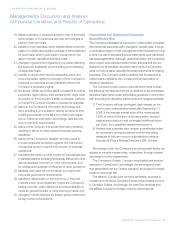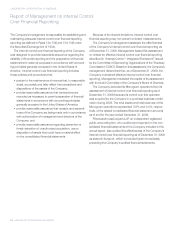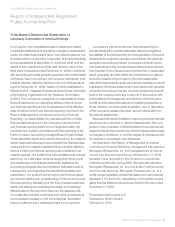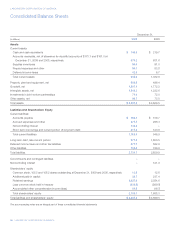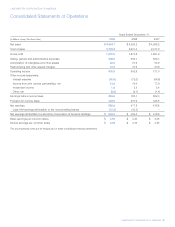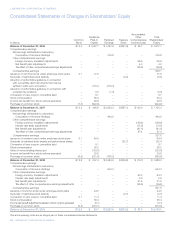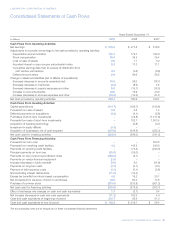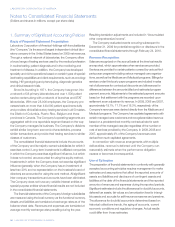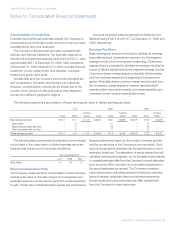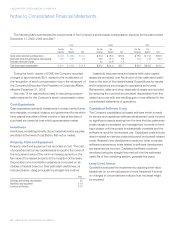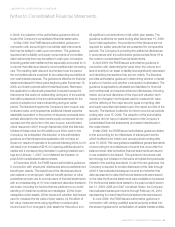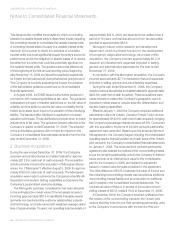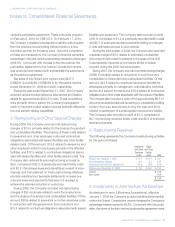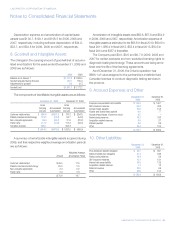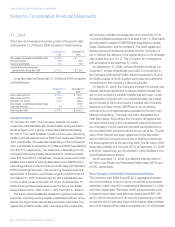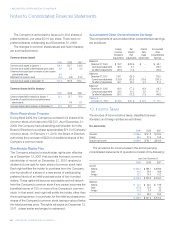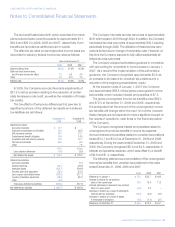LabCorp 2009 Annual Report Download - page 45
Download and view the complete annual report
Please find page 45 of the 2009 LabCorp annual report below. You can navigate through the pages in the report by either clicking on the pages listed below, or by using the keyword search tool below to find specific information within the annual report.LABORATORY CORPORATION OF AMERICA 43
LABORATORY CORPORATION OF AMERICA
Notes to Consolidated Financial Statements
Long-lived assets, other than goodwill, are reviewed for
impairment whenever events or changes in circumstances
indicate that the carrying amounts may not be recoverable.
Recoverability of assets to be held and used is determined by
the Company at the level for which there are identifiable cash
flows by comparison of the carrying amount of the assets to
future undiscounted net cash flows before interest expense
and income taxes expected to be generated by the assets.
Impairment, if any, is measured by the amount by which the
carrying amount of the assets exceeds the fair value of the
assets (based on market prices in an active market or on dis-
counted cash flows). Assets to be disposed of are reported at
the lower of the carrying amount or fair value.
The Company completed an annual impairment analysis of
its indefinite lived assets, including goodwill, and has found no
instances of impairment as of December 31, 2009.
Intangible Assets
Intangible assets (patents and technology, customer relationships
and non-compete agreements), are amortized on a straight-line
basis over the expected periods to be benefited, such as legal life
for patents and technology, 10 to 25 years for customer lists and
contractual lives for non-compete agreements.
Debt Issuance Costs
The costs related to the issuance of debt are capitalized and
amortized to interest expense using the effective interest
method over the terms of the related debt.
Professional Liability
The Company is self-insured (up to certain limits) for profes-
sional liability claims arising in the normal course of business,
generally related to the testing and reporting of laboratory test
results. The Company estimates a liability that represents the
ultimate exposure for aggregate losses below those limits. The
liability is discounted and is based on a number of assump-
tions and factors for known and incurred but not reported
claims based on actuarial assessment of the accrual driven by
frequency and amount of claims.
Income Taxes
The Company accounts for income taxes utilizing the asset
and liability method. Under this method deferred tax assets
and liabilities are recognized for the future tax consequences
attributable to differences between the financial statement
carrying amounts of existing assets and liabilities and their
respective tax bases and for tax loss carryforwards. Deferred
tax assets and liabilities are measured using enacted tax rates
expected to apply to taxable income in the years in which those
temporary differences are expected to be recovered or settled.
The effect on deferred tax assets and liabilities of a change in
tax rates is recognized in income in the period that includes
the enactment date. The Company does not recognize a tax
benefit, unless the Company concludes that it is more likely than
not that the benefit will be sustained on audit by the taxing
authority based solely on the technical merits of the associated
tax position. If the recognition threshold is met, the Company
recognizes a tax benefit measured at the largest amount of the
tax benefit that the Company believes is greater than 50%
likely to be realized. The Company records interest and penal-
ties in income tax expense.
Derivative Financial Instruments
Interest rate swap agreements, which are currently being used
by the Company in the management of interest rate exposure,
are accounted for at fair value. The Company’s zero-coupon
subordinated notes contain two features that are considered to
be embedded derivative instruments under authoritative guidance
in connection with accounting for derivative instruments and
hedging activities. The Company believes these embedded
derivatives had no fair value at December 31, 2009 and 2008.
See note 18 for the Company’s objectives in using derivative
instruments and the effect of derivative instruments and related
hedged items on the Company’s financial position, financial
performance and cash flows.


